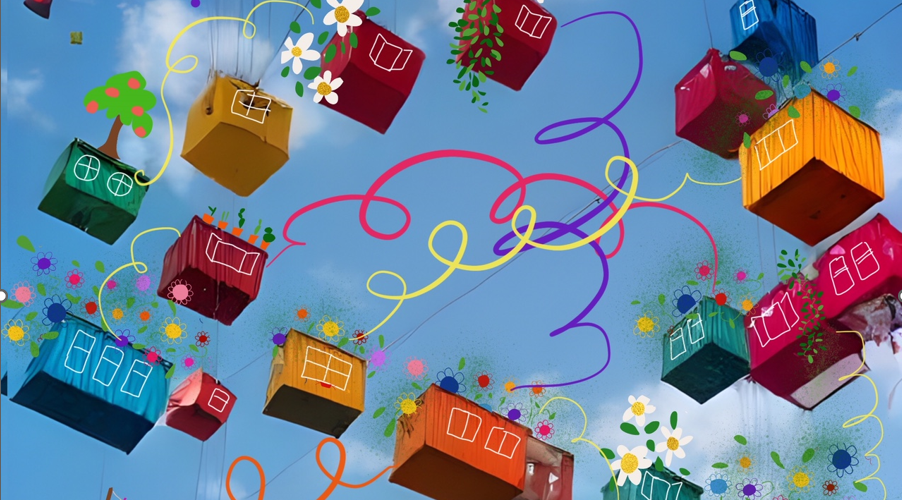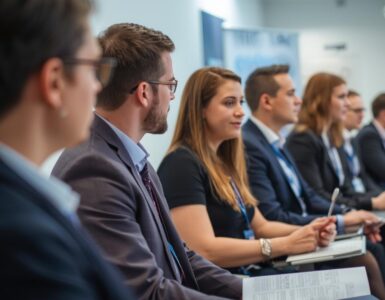by Chrissi Nerantzi, University of Leeds, UK.
What is this about? Well, when I think about digital portfolios, the word “container” comes to mind. Philip Abrami and Helen Barrett have used the term “container” in relation to digital portfolios long before I did… Today, I would like to attempt stretching this metaphor a little bit further to reflect on the purpose, process, people and product dimensions of digital portfolios.
While containers feel ridged, dark, hard and super heavy, they can be so much more for learning and assessment in higher education.
Digital portfolios as containers store stuff. They resemble elastic and super stretchy and expandable storage boxes that live and grow in the digital interconnected ecosystem or a personal device, not always shared with others. The purpose of such digital portfolios may vary. It can be for documenting, gathering, curating, collecting and stitching together things we have grabbled with, in a module, a programme and other things that interest us more widely. We can also capture what we have done to showcase outputs and products. Also what moves us. The process. We write about it, draw it, say it with a song, a poem, a story, a model or a cake even. Some would argue, GenAI can do all that for us. Yes, it probably can. Even cake I suspect… But what is the point? This question takes me back to something I wrote recently about rethinking assessment in relation to its value, variety and variety.
The plurality and diversity of formats of digital portfolios to share our learning-in-progress, stories, document and showcase our work has been enabled through participatory multimedia. We are all natural storytellers and makers. It is true that a portfolio can be varied, a rich patchwork indeed, inclusive and equitable when we know how to harness the power of digital and multimedia for our learning and assessment! Creative and arts-based approaches help us notice and express our lived experience and associated reflections with greater richness and diversity. Digital media provide additional opportunities in this area making our work sharable more widely. It also helps those at the margines. Remember the drawings, songs, stories, models we just mentioned? See applications of LEGO® SERIOUS PLAY® in higher education for example. Reflective practice is so much more than just writing. Check out some of the creative activities included in the guide by Marina Harvey and colleagues for inspiration.
Digital portfolios as containers with windows. Windows which open and through which we explore (im)possibilities. The open windows could indicate exchange, connection and cross-fertilisation. Windows lead us to expansive playgrounds to question, experiment, explore, try, fail, try again and again, learn. Questions remind me of Socrates, Freire and hooks. To reflect! To capture the process of learning. A landscape of messy challenges, a “swampy lowland” as characterised by Donald Schön, emerging ideas, worries and dilemmas, things we tried that worked and things we tried that haven’t (worked yet… and may never work). Things that feed our imagination, curiosity and journey. The eureka moments, the breakthroughs! Things which illuminate the critical and creative thinker and maker in us, the doer. The problem poser and problem solver. Does all this happen in isolation from others? The world?
The recipes we often use to develop reflection are predominantly cyclical ones and seem to portrait reflection as a highly individualised experience. An experience that is followed by reflection (or should I say reflective writing?) and in a linear way. Too much structure can be problematic. Asking students to reflect and reflect and reflect can also cause fatigue. These recipes have been questioned by Melaine Coward, Lee Fallin, Jayson Seaman… However, we continue using many of them routinely. Reflection is messy. Reflection is interconnected with others and the world. We know this. Al James and Stephen D. Brookfield‘s reflective model provides an alternative to the dominant linear and cyclical approaches. Their model aims to awaken imagination, creativity, criticality, and playfulness within what they call “the whole person” and illustrates interconnectedness among academic, work, personal and social life. Connections among people and ideas. The whole learning ecosystem! These dimensions mean that the windows in our container are open and that the container can and will travel, which takes us to the next point.
Digital portfolios as travelling containers with windows. Containers are built to store and to travel. Not travelling may trap us in our own thoughts. While negative and positive thoughts and emotions provide insights, they can cloud our judgement if captured in isolation. There is a need for dialogue, debate, connection. In networks and communities. With people. We are social beings, remember? James and Brookfield’s model show this with clarity (see earlier). Brookfield’s Four Lenses developed with a focus on developing critical reflection in teaching also emphasizes on the importance of voices and practices of others. He speaks about lenses and the role they play to aid reflective thinking. I think that Brookfield’s Four Lenses are useful beyond developing reflective practice in teaching as it illuminates “others” and the key role they play in our own development, therefore framing reflection as a social and situated practice.
If creative and critical problem-solvers, active citizens and lifelong and lifewide learners ( see EUA report “Universities without walls: A vision for 2030“) are what our world wants and needs, how can we transform digital portfolios into travelling or even flying containers with windows that accompany us beyond the boundaries of a course, a module a programme of study as lifewide and lifelong learning companions? Can thinking about the purpose, process, people and product dimensions of portfolios help us design for truly meaningful engagement with these?

Author
Chrissi Nerantzi (NTF, CATE, PFHEA) is a Professor in Creative and Open Education in the School of Education, a Senior Lead of the Knowledge Equity Network and the Academic Lead for Discover and Explore at the University of Leeds in the United Kingdom.*The featured picture was generated using https://deepai.org/ as a response to the prompt: Randomly flying colourful containers with windows in the sky in different directions connected by strings.” After multiple unsuccessful attempts, the image used was imported to the Sketches app and missing features that were closer to what I had imagined and was trying to visualise were added manually.














